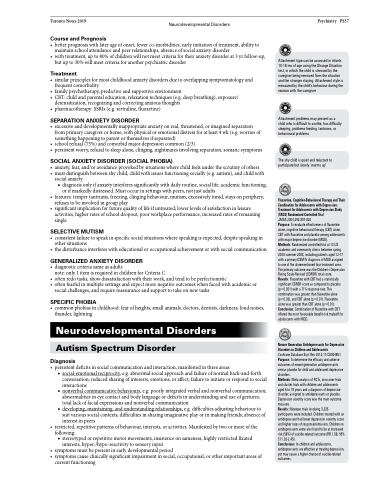Page 1201 - TNFlipTest
P. 1201
Toronto Notes 2019 Neurodevelopmental Disorders
Course and Prognosis
• betterprognosiswithlaterageofonset,fewerco-morbidities,earlyinitiationoftreatment,abilityto maintain school attendance and peer relationships, absence of social anxiety disorder
• withtreatment,upto80%ofchildrenwillnotmeetcriteriafortheiranxietydisorderat3yrfollow-up, but up to 30% will meet criteria for another psychiatric disorder
Treatment
• similarprinciplesformostchildhoodanxietydisordersduetooverlappingsymptomatologyand frequent comorbidity
• familypsychotherapy,predictiveandsupportiveenvironment
• CBT:childandparentaleducation,relaxationtechniques(e.g.deepbreathing),exposure/
desensitization, recognizing and correcting anxious thoughts
• pharmacotherapy:SSRIs(e.g.sertraline,fluoxetine)
SEPARATION ANXIETY DISORDER
• excessiveanddevelopmentallyinappropriateanxietyonreal,threatened,orimaginedseparation from primary caregiver or home, with physical or emotional distress for at least 4 wk (e.g. worries of something happening to parent or themselves if separated)
• schoolrefusal(75%)andcomorbidmajordepressioncommon(2/3)
• persistentworry,refusaltosleepalone,clinging,nightmaresinvolvingseparation,somaticsymptoms
SOCIAL ANXIETY DISORDER (SOCIAL PHOBIA)
• anxiety,fear,and/oravoidanceprovokedbysituationswherechildfeelsunderthescrutinyofothers
• mustdistinguishbetweenshychild,childwithissuesfunctioningsocially(e.g.autism),andchildwith
social anxiety
■ diagnosis only if anxiety interferes significantly with daily routine, social life, academic functioning,
or if markedly distressed. Must occur in settings with peers, not just adults
• features:tempertantrums,freezing,clingingbehaviour,mutism,excessivelytimid,staysonperiphery,
refuses to be involved in group play
• significantimplicationforfuturequalityoflifeifuntreated;lowerlevelsofsatisfactioninleisure
activities, higher rates of school dropout, poor workplace performance, increased rates of remaining single
SELECTIVE MUTISM
• consistentfailuretospeakinspecificsocialsituationswherespeakingisexpected,despitespeakingin other situations
• thedisturbanceinterfereswitheducationaloroccupationalachievementorwithsocialcommunication
GENERALIZED ANXIETY DISORDER
• diagnosticcriteriasameasadults
note: only 1 item is required in children for Criteria C
• often redo tasks, show dissatisfaction with their work, and tend to be perfectionistic
• often fearful in multiple settings and expect more negative outcomes when faced with academic or
social challenges, and require reassurance and support to take on new tasks
SPECIFIC PHOBIA
• commonphobiasinchildhood:fearofheights,smallanimals,doctors,dentists,darkness,loudnoises, thunder, lightning
Neurodevelopmental Disorders
Autism Spectrum Disorder
Diagnosis
• persistentdeficitsinsocialcommunicationandinteraction,manifestedinthreeareas
■ social-emotional reciprocity, e.g. abnormal social approach and failure of normal back-and-forth
conversation; reduced sharing of interests, emotions, or affect; failure to initiate or respond to social
interactions
■ nonverbal communicative behaviours, e.g. poorly integrated verbal and nonverbal communication;
abnormalities in eye contact and body language or deficits in understanding and use of gestures;
total lack of facial expressions and nonverbal communication
■ developing, maintaining, and understanding relationships, e.g. difficulties adjusting behaviour to
suit various social contexts; difficulties in sharing imaginative play or in making friends; absence of
interest in peers
• restricted,repetitivepatternsofbehaviour,interests,oractivities.Manifestedbytwoormoreofthe
following:
■ stereotyped or repetitive motor movements, insistence on sameness, highly restricted fixated
interests, hyper-/hypo-reactivity to sensory input
• symptomsmustbepresentinearlydevelopmentalperiod
• symptomscauseclinicallysignificantimpairmentinsocial,occupational,orotherimportantareasof
current functioning
Psychiatry PS37
Attachment type can be assessed in infants 10-18 mo of age using the Strange Situation test, in which the child is stressed by the caregiver being removed from the situation and the stranger staying. Attachment style is measured by the child’s behaviour during the reunion with the caregiver
Attachment problems may present as a child who is difficult to soothe, has difficulty sleeping, problems feeding, tantrums, or behavioural problems
The shy child is quiet and reluctant to participate but slowly ‘warms up’
Fluoxetine, Cognitive-Behavioural Therapy and Their Combination for Adolescents with Depression: Treatment for Adolescents with Depression Study (TADS) Randomized Controlled Trial
JAMA 2004;292:807-820
Purpose: To evaluate effectiveness of fluoxetine alone, cognitive behavioural therapy (CBT) alone, CBT with fluoxetine and placebo among adolescents with major depressive disorder (MDD).
Methods: Randomized controlled trial at 13 US academic and community clinics between spring 2000-summer 2003, including patients aged 12-17 with a primary DSM IV diagnosis of MDD assigned to one of the aforementioned four treatment arms. The primary outcome was the Children’s Depression Rating Scale-Revised (CDRSR) total score.
Results: Fluoxetine with CBT had a statistically significant CDRSR score as compared to placebo (p=0.001) with a 71% response rate. This combination was greater than fluoxetine alone (p=0.02), and CBT alone (p=0.01). Fluoxetine alone was greater than CBT alone (p=0.01). Conclusion: Combination of fluoxetine with CBT offered the most favourable benefit-risk tradeoff for adolescents with MDD.
Newer Generation Antidepressants for Depressive Disorders in Children and Adolescents
Cochrane Database Syst Rev 2012;11:CD004851 Purpose: To determine the efficacy and adverse outcomes of newer generation antidepressants versus placebo for child and adolescent depressive disorders.
Methods: Meta-analysis of RCTs, crossover trials and cluster trials with children and adolescents aged 6 to 18 years and a diagnosis of depressive disorder, assigned to antidepressants or placebo. Depression severity score was the main outcome measure.
Results: Nineteen trials involving 3,335 participants were included. Children treated with an antidepressant had lower depression severity score and higher rates of response/remission. Children on antidepressants were also found to be at increased risk (58%) of suicide-related outcome (RR 1.58; 95% CI 1.02-2.45).
Conclusions: In children and adolescents, antidepressants are effective at treating depression, yet may cause a higher chance of suicide-related outcomes.


